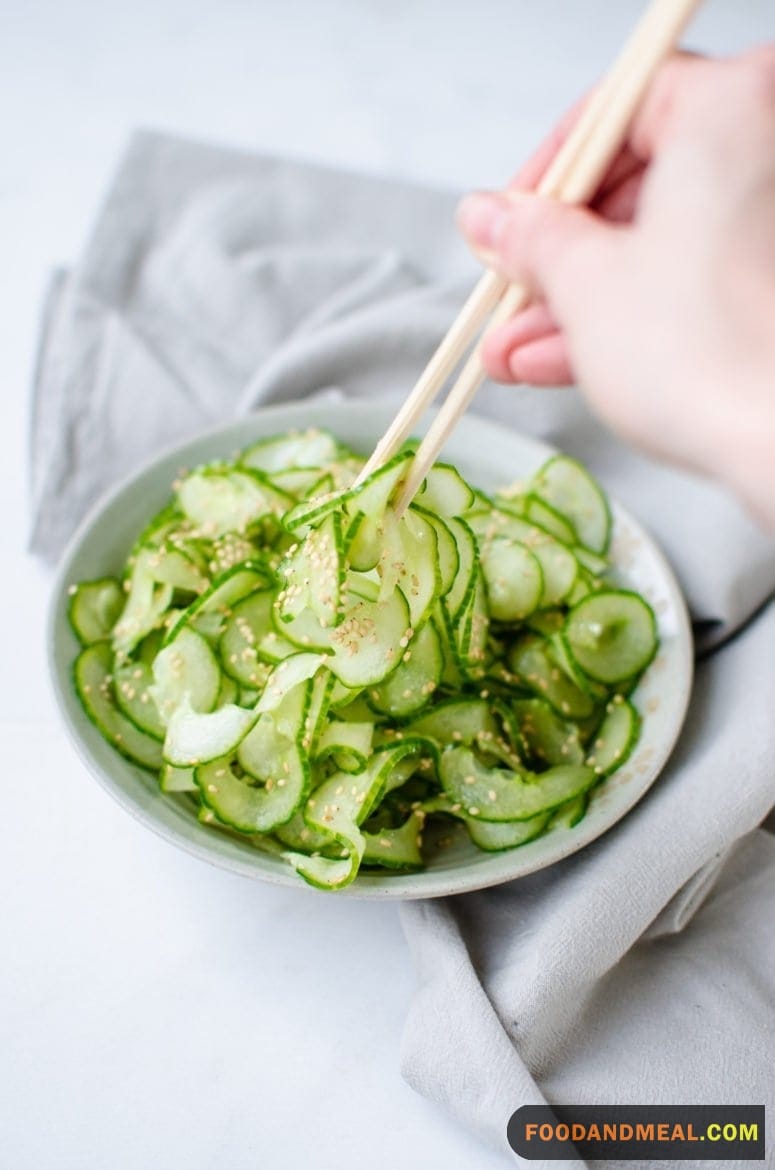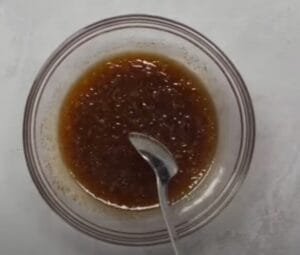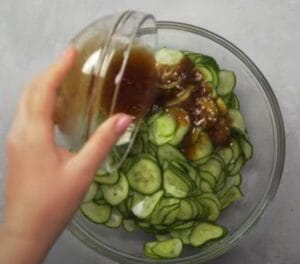Enjoy a light, healthy side with our simple Sunomono recipe—crisp cucumbers in a delicate rice vinegar dressing.”
Recently, I discovered a light and refreshing Japanese cucumber salad called sunomono that truly delighted my palate. The sweet yet tart flavors of the rice vinegar dressing paired perfectly with the crisp crunch of the cucumbers.
I fondly recall my first taste of sunomono at a local Japanese restaurant. With the very first bite, my eyes lit up with delight at the bright flavors dancing on my tongue. I quickly devoured the small starter portion, though it left me craving for more. From then on, I would order a double portion of that revitalizing salad at every visit.
When a craving hit for that tangy cucumber dish, I decided to try my hand at making Hapanese cucumber salad at home. After a few tweaks here and there, I crafted my perfect version – cool, crisp cucumbers splashed with a well-balanced sweet and sour dressing. Now, I can enjoy this light, palate-cleansing salad anytime without restraint.
As a chef at Food And Meal, I’m always seeking out new flavor combinations and dishes to add to my repertoire. This sunomono salad recipe is now a staple in my kitchen rotation. I hope you’ll find as much joy in its sweet and tangy flavors as I have. Now, let’s get cooking!
Sunomono Recipes
Sunomono is a light and refreshing Japanese Style Cucumber salad. Typically made from cucumbers and wakame, this dish is typically served cold and as a side dish. The vinegar dressing is very refreshing and goes perfectly with fatty cuts of meat. To get the most flavor out of sunomono, serve it with a grilled fish. To make it even more interesting, mix it with rice noodles. Enjoy!


Sunomono - Cucumber Salad
Equipment
Ingredients
- 2-3 cups cucumber use Japanese or other thin-skinned cucumbers, sliced as thinly as possible
- ¼ teaspoon salt
- 3 tablespoon rice vinegar
- 1 tablespoon sugar
- ¼ teaspoon soy sauce
- 1 teaspoon sesame seeds
Instructions
- Add salt to the sliced cucumbers and mix well.

- Let them sit for 5 minutes.

- Meanwhile, combine the vinegar, sugar, and soy sauce in a small bowl until the sugar is completely dissolved.

- Set aside.

- Drain away all the liquid, squeezing as much as you can from cucumbers.

- Add the vinegar mixture and sesame seeds to the prepared cucumbers

- Mix well

- Enjoy!

Video
Notes
Nutrition
© Food And Meal
This website provides approximate nutrition information for convenience and as a courtesy only. Nutrition data is gathered primarily from the Spoonacular Database, whenever available, or otherwise other online calculators.
How to make Sunomono with a Food Processor

When using a best food processor, it’s important to select the appropriate blade for slicing. The goal is to achieve thin, even slices that will absorb the vinegar dressing well and present beautifully on the plate. There’s a certain satisfaction in watching the food processor work its magic, each slice uniform and precise, a testament to the wonders of modern kitchen technology.
However, it’s worth noting that while the food processor excels in efficiency, it may not replicate the nuanced, hand-cut quality some purists seek in traditional sunomono recipe. There’s a personal touch to hand-slicing that machines can’t quite emulate. Yet, this shouldn’t detract from the joy of using a food processor, especially for those who value practicality and are eager to enjoy the flavors of Cucumber salad without the more labor-intensive aspects of its preparation.
The emotional experience of making sunomono with a food processor is different from the traditional method. It might lack some of the contemplative quietude, but it brings its own form of contentment, especially for those who feel a sense of accomplishment from working smartly and efficiently. There’s a pleasure in knowing that even with a busy schedule, one can still prepare a dish that is both healthful and aesthetically pleasing.
Expert Tips for making Sunomono

Cooking Tips about Sunomono Salad Recipe
When approaching sunomono, it’s essential to consider the delicate nature of the ingredients and the subtlety of the dressing. The foundation of many japanese cucumbers dishes is thinly sliced cucumbers, which should be prepared with attention to their crispness and freshness. One might feel a sense of tranquility while slicing the cucumbers; the repetitive motion can be quite meditative, and the sound of the knife against the cutting board acts like a rhythmic backdrop to the culinary experience.
To enhance the texture and flavor of the cucumbers, they are often salted and then left to sit for a period. This process draws out excess water, resulting in a firmer texture which is more receptive to the vinegar dressing. It’s somewhat magical to see this transformation, knowing that such a simple technique can have a profound effect on the final dish.
The dressing for sunomono recipe is traditionally made from rice vinegar, sugar, and sometimes soy sauce or sesame oil. Achieving the right balance between sweet and sour is key, and one should approach this task with a spirit of experimentation and patience. The rice vinegar’s gentle acidity should enliven the palate without overwhelming it, and the sugar’s sweetness should provide a counterpoint that is harmonious, not cloying.
If including seafood, such as shrimp or octopus, it should be cooked just until done to maintain its tenderness and then cooled before being incorporated into the salad. This respect for the ingredient’s inherent qualities is a testament to the thoughtful nature of Japanese culinary practices.
Assembling the dish is an exercise in aesthetic judgment as well as taste. The components should be arranged in a way that is pleasing to the eye, with consideration for color and form. Enjoyment of sunomono begins with the eyes, and the presentation is an invitation to savor the flavors to come.
Serving Suggestions

This light and refreshing sunomono salad would pair nicely with some sashimi, making it a perfect starter for a Japanese-inspired meal. The tangy flavors would also balance out something like teriyaki chicken or grilled salmon.
For a heartier salad, you could add some cooked shrimp, crab meat or even thinly sliced beef. Toppings like avocado, edamame or crispy wonton strips would also make tasty additions.
I like to keep some sunomono salad in my fridge to enjoy as a palate-cleansing side dish anytime. It goes great with all kinds of Asian-inspired dishes from stir fries to rice bowls. And it can be a nice change of pace from leafy green salads.
However you choose to enjoy this sweet and sour cucumber salad, I hope it brings a delightful tangy crunch to your next meal!
Top 9 FAQs about Sunomono Recipe

- What is sunomono made of? Sunomono recipe typically consists of thinly sliced cucumbers, a dressing made with rice vinegar, sugar, and soy sauce, and sometimes additional elements like sesame seeds or seaweed.
- What is the difference between namasu and sunomono? Namasu is a type of sunomono, but not all sunomono is namasu. Namasu specifically refers to a dish where vegetables like daikon and carrots are thinly sliced and marinated in a sweetened rice vinegar mixture, while Japanese cucumber salad encompasses a broader category of vinegared dishes that may include various ingredients like seafood or other vegetables.
- What is a Japanese cucumber? Japanese cucumbers, or kyuri, are slender, seedless cucumbers with thin, tender skin. They are mild and slightly sweet, contributing to the delicate flavor of Japanese dishes like Sunomono.
- Is Sunomono salad good for you? Yes, Sunomono can be a healthy choice. Cucumbers are low in calories and high in hydration, and the vinegar-based dressing adds flavor without many calories. It also provides a refreshing and light option, especially in hot weather.
- Can I prepare Sunomono in advance for a party? Yes, you can prepare the Sunomono dressing and slice the cucumbers in advance. Combine them just before serving to maintain the salad’s crispness.
- How long can I store Sunomono? Sunomono is best enjoyed fresh. If you have leftovers, store them in an airtight container in the refrigerator for up to 24 hours, but it may lose some crispness.
- Can I use regular cucumbers instead of Japanese cucumbers? While Japanese cucumbers are ideal, you can use regular cucumbers. Just remove the seeds for a similar texture.
- What’s the best way to maintain the salad’s crunchiness? The key to crisp Sunomono is thorough chilling. Allow it to rest in the refrigerator for at least 30 minutes before serving.
- Can I adjust the sweetness of the dressing to my taste? Absolutely! Feel free to adjust the sugar in the dressing to your preferred level of sweetness. Taste and customize the dressing to your liking.
Conclution
In closing, I hope this light and refreshing sunomono salad has delighted your tastebuds as much as it has mine. The sweet, tart dressing pairs so perfectly with the cool crunch of fresh cucumbers. I find this salad to be a bright spot on any table, whether served as an appetizer, side dish or even a light lunch.
I encourage you to experiment with adding your own creative twists – perhaps some thin slices of avocado for creaminess, shredded carrots for extra crunch, or even some cooked shrimp or chicken for a heartier meal. The possibilities are endless!
As a chef and sunomono fanatic, it brings me joy to share this beloved recipe so that you too can craft the perfect version in your own kitchen. If you make this zesty, Japanese-inspired cucumber salad, I’d love to hear about it! Leave a comment below describing your experience with this recipe. I’m always thrilled to talk food with a fellow home cook. Now get out there are start delighting your tastebuds with sunomono recipe!
I'm James F Anderson, a noted sous chef from London and a Le Cordon Bleu alumnus. My career began in a Michelin-starred Parisian eatery, where my blend of classic and contemporary cooking, using seasonal ingredients, earned accolades. Recognized in culinary publications and on cooking shows, I’m committed to mentoring aspiring chefs and delivering memorable dining experiences, marking me as a standout talent in the culinary world.









